★ Illusion of Separation ★ Sociophysical Postulates I – XI ★
First, a Riddle:
What’s Both Hot and Cold,
Vibrates and Resonates,
And Is Made Out Of At Least Two Kinds of Stars?
What Is The Speed of Thought Today?
ϕ Sociophysical Mechanics Are Now Predominantly Virtualized
ϕ Memes, Datums and Iota
ϕ Holons and the Holonome
Temperature, Density, Waves and Spectra
ϕ The Speed of Sound
ϕ Cultural Reverberation
ϕ The Economics of Information
Epistemological Petrification and Transfiguration
ϕ With 2.0, Knowledge Upgrades Its TTL
ϕ An Individual’s Focus is the 21st Century Commodity
ϕ The Semiotic Aggregate of Thought
ϕ Environmental Stimuli and Cultural Universals Shape The Aggregate of Thought
The Eudaimonic Symphony of Being Humanity
ϕ The Beginning of the End for the Illusion of Separation?
ϕ The Singularity is a Sociophysical Black Hole
The Other Side of the S-Curve
ϕ Open and Closed Systems
ϕ Uncountably Infinite Dimensional, Convoluted Non-Linear Systems
Phase Change in Physical and Aphysical Topologies
ϕ Complexity in Sociophysical Systems Creates Vastly Many Phases
ϕ Demand-Side Information Economics
ϕ Does The Commoditization of Attention Extend to Automated Agents?
Spectral Decoherence in the Noosphere
ϕ The Structure of the Noosphere
ϕ Ontologies in Data Science
ϕ Neighborhoods in Physical and Aphysical Topologies
ϕ What is Anscombe’s Paradox, Watson
ϕ The 15th Century European Noosphere
ϕ The Obliteration of Physical Constraints on Sociophysical Phenomena
ϕ Which One Of These Is The Fake News Article?
A Tall Glass of Nihilism to Toast Your Postmodernist Wasteland
ϕ Spectral Decoherence Breaks the Economics of Content Creation
ϕ Semiotic Harmonics and Social Engineering
ϕ Information Warfare in Our Brave New World
Shangri-La Or Bust
ϕ The Ablation of Causality
“Posthumous men — I, for example — are understood worse than timely ones, but heard better. More precisely: we are never understood — hence our authority.” — Nietzsche, Twilight of the Idols
What Is The Speed of Thought Today?
Impulses between neurons can travel over 100 meters per second. Instead, consider the speed at which a thought can travel across the world and how has it changed over time. After all, our individual thoughts lead to words and actions, which ripple through social networks both natural and virtual. Throughout history, this velocity of information has steadily increased until it exploded in the 19th century with the telegraph.
Sociophysical Mechanics Are Now Predominantly Virtualized
While communication was bound to physical interactions, a primarily physical set of mechanics dominated social physics and the movement of information. Today, the convergence of virtual communication channels like social media causes physical mechanics to recede. From here, social physics becomes dominated by metaphysical modes of action, where propagation becomes dependent on the geometric mechanics of information. So, the geometry and structure of the information itself as it fits into its contexts determines its motion along virtual channels.
Memes, Datums and Iota
In this series, meme refers to something between a unit of cultural information and a unit of its transmission. A datum, which can represent a meme, refers to a structure of information, dependent from and potentially linked to its instantiations in various networks and spaces. To distinguish it from common connotations of data, it’s pluralized here as datums. Here, iota refers to datum instantiations in spaces and networks, where each iota is a singleton type.
The Tao that can be spoken is not the eternal Tao
The name that can be named is not the eternal name
The nameless is the origin of Heaven and Earth
The named is the mother of myriad things
It is an interesting exercise to think of datums – units of information – as being particles and waves with spectra, similar to Einstein’s eureka of light as both a particle and a wave. In this manner, datums can be imagined as myriad types of molecules, each and all vibrating with faint deviation to characteristic modes. They are molecular in the sense that they are composed from more elemental datums. The nature of information and its wide speciation expand datum variety in tetrationally intricate ways. Internalization of this endless variety of information is what it takes to truly determine anything about social physics, though most representations map sparsely to the range of possibilities. Memes are like monoidal, higher types of datums.
Tetration on the Complex Plane

Holons and the Holonome
Holons are a useful concept for structuring information. All possible prototypical structures for information can be combinatorially enumerated using category theory. A fitting name for this is the holonome and, ideally, its enumeration would be countably infinite. Understanding this holonome and developing a structure of information that resolves duality and defines all possilble metaphysical forms drives my passion for learning category theory. Holons correspond to the concept of lenses and prisms from functional programming. The holonome is unique. There is only one and it encompasses all possible structures of holons, without regard for their contents.
Temperature, Density, Waves and Spectra
Sociophysical systems exhibit a wide array of behavior that can be modeled with physics metaphors. From atop a ziggurat in Sumeria or Mesoamerica, some of the basic sociophysical mechanics emerge visibly as patterns of interaction in crowds. The movement of people in a mall have a temperature, as they do at wider geographic scales. Density and temperature correlate with interest and intent. Moreover, both the temperature and density of the group yield more connections and a faster rate of information diffusion.
A Change In Elevation Results in a Change in Perspective. Here, It Is A Dimensional Reduction

What’s Both Hot and Cold,
Vibrates and Resonates,
And Is Made Out Of At Least Two Kinds of Stars?
The answer to the riddle above is people, or sociophysical networks, which have spaces of varying topology: physical spaces and more logical spaces. In one we are literally made of star dust and, in the other, star-like images emerge from graphs.
The Speed of Sound
Extending the parallels to temperature and density yields a metaphor to the speed of sound. It describes the potential speed at which general information could travel. An overly simplified construction cannot so effectively model diffusion of specific pieces of information, since people exhibit choice over the information they propagate. It instead assumes temperature and density correlate with higher potential for interactions to occur. As you geographically zoom out, the potential speed of information diffusion becomes more closely coupled to temperature and population density.
Cultural Reverberation
From ancient times through the telegraph, all information flux was bound to physical contact. Population growth itself gradually accelerated both information accumulation and flux. Writing established information permanence. Navigation and ship-building increased the maximum physical range for information to spread per social degree of exchange. Economics incentivized management of information not only to predict trade and anticipate resource trends, but to influence them as well. Ancient people may have assumed the network effect: as population increased, so did the likelihood of technological innovations and thus, information might begin to spread faster than it was driven by population density alone.
The Economics of Information
Wherever there is supply and demand, you’ll find economic dynamics and information is no exception. While no one in Germany counted all the Bibles in 1350, the notions that documents are tangible and countable themselves change how people react to perceived supply and demand. Unwritten records are much harder to pin down, but what’s the use in bartering for a juicy piece of gossip if you don’t get it early on? Information conveys power when it is scarce, even when it may not be true. When a rumor is held tightly, it is easier to trace. While we never poll our friends to tally up an information histogram, our mind is always making inferences because the distribution of information usually tells us more than the info itself. Small talk may be all about the weather and the Yankees, but it informs us about who talks to who and more.
Epistemological Petrification and Transfiguration
Macroscopically, technology’s effect on information diffusion produced viral sociocultural transformation, often with political or economic consequences. Writing developed once and was never forgotten. The more a mythos the more calcified it became. Religious systems gradually petrified upon exposure to clay tablets, locking these ephemeral systems of thought into place. The printing press democratized writing, effectively seizing it from the priest class by undermining the economics that enabled tight control.
Prior to the printing press, the narrow spectrum of available info fluctuated perpetually. Rationalism wasn’t even a fleeting dream at this point. All written records were copied manually. Accumulation of writing was roughly bounded by the literate population, which can be conceived as a kind of abstract membrane whose size also loosely correlated to a population’s permeability to written records. Copies more numerous and accessible resulted in more frequently amplified information. If the work wasn’t financed by the church or state, the information’s TTL drastically plummeted.
With 2.0, Knowledge Upgrades Its TTL
Information and knowledge have time-to-live values, similar to the IP protocol’s TTL value, which is the number of times a packet will be retransmitted by routers without final delivery. For knowledge, this TTL is related to the number of probable hosts or physical representations and the probabilities of events where such representations are retransmitted. As time continues onwards, these probabilities fluctuate, as do the number of retained hosts, iota and datum representations. In some cases, when information itself is lost, it can be later reconstituted and repersisted from its parts.
People respond in different ways to datums, arising from traits such as virility or vociferousness. These aspects drive expansion in the datums’ lineage of iota, which are seeded into hosts. The more expansive the distribution of iota and the more frequently they’re expressed in communication, the higher their degree of consensus among hosts. Those datums linked to natural phenomena or semiotically connected to cultural universals are innately amplified by being in phase with common sensory stimuli that pervade the human condition.
An Individual’s Focus is the 21st Century Commodity
Paralleling Zipf’s distribution – frequency of word usage for a lexicon – there is a similar distribution that describes the frequency of components of thoughts including semiotic signifiers. Its data can’t be directly sampled, and like so many other aspects of social physics, this distribution is nearly impossible to quantify. This distribution has always been important to understand. In the 21st century, where your attention has been commoditized, there is nothing more important than understanding what consumes our thought. This distribution can be partially seen on Google Trends; both attempting to quantify it and reasoning about it are immensely valuable in the Marketing or Search Engine Optimization fields. If you can watch enough commercials, you can see how this impacts both the design and strategy of advertising. Symbols that are nearly universal and those which are as yet undefined in most minds are each necessary for effective advertising, publicity and brand management.
Zipf’s Distribution Plots the Frequency of Words As They Appear In A Language’s Literature
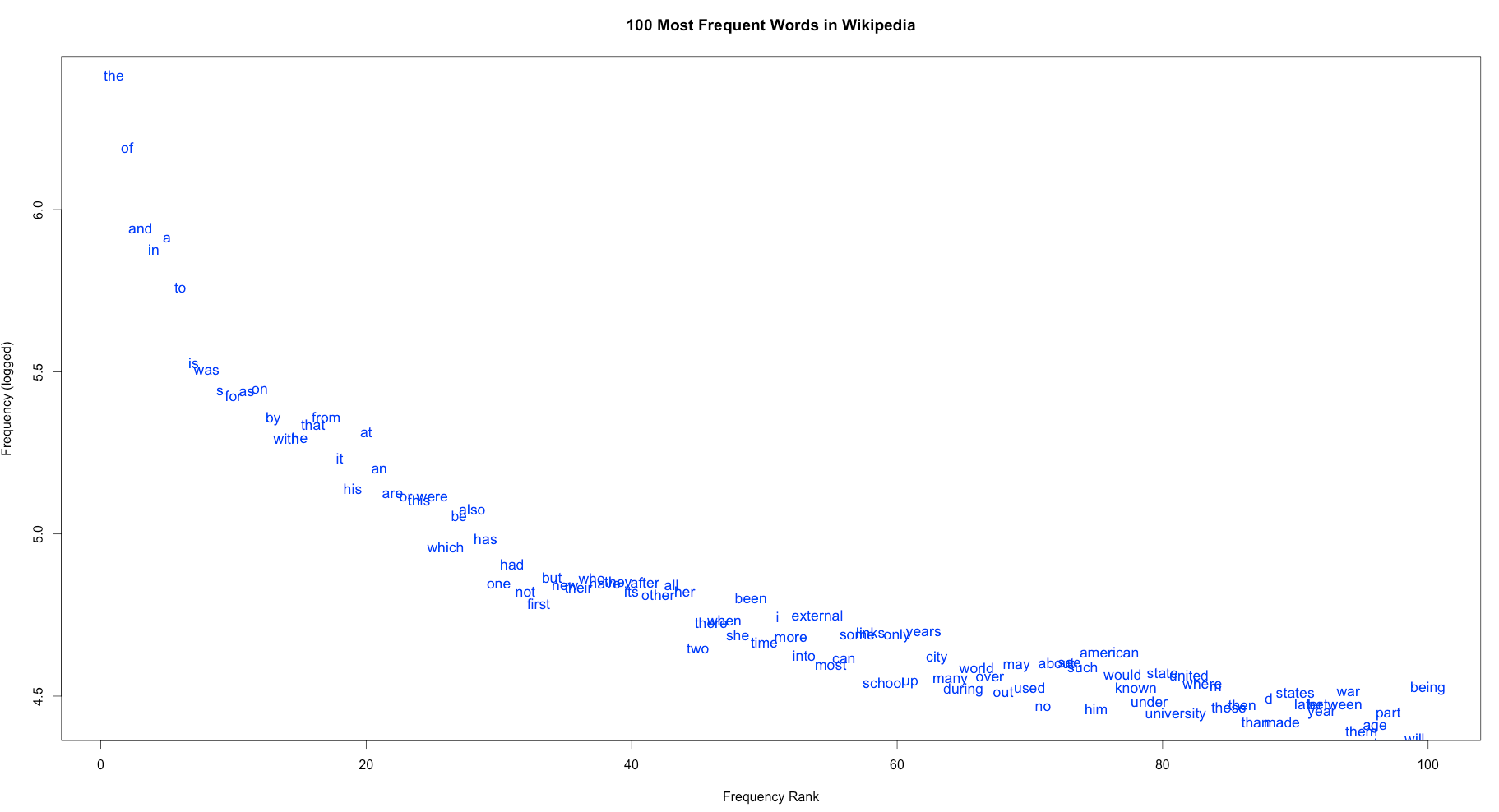
The Semiotic Aggregate of Thought
What semiotic signifiers does an individual spend the most time thinking about? How can these signs be grouped? If we zoom out to various scales of society, how does this distribution change? Why? What do the subtle variations between Zipf’s distribution for languages tell us? Aren’t they slightly different organizations of morphemic pointers to the same set of semiotic signs? What always floats to the top of Zipf’s distribution for any given language? Above all else, our shared cultural universals sift to the top.
Environmental Stimuli and Cultural Universals Shape The Aggregate of Thought
The Zipf’s distribution for any given language is simply a reflection of the immeasurable semiotic distribution mentioned above. The semiotic aggregate of human focus is predominantly derived from ideas constructed from cultural universals. The cultural universals float to the top because they arise from human needs and the intricacies of human interactions. What happens to this distribution when technology changes our human needs? Is there ever such a thing as a new cultural universal? It must be so, but how?
Writing and subsequent innovations dramatically expanded the spectrum and TTL of information. Before there were written records, reflections of the information only persisted if they were retransmitted faster than they decayed. Signal could be quickly and easily drowned out by encouraging the prioritization of competing datum.
After writing emerged, suppression of information required the location and destruction of all physical instantiations of that information. To purge any records with certainty meant locating them without raising alarm. After the printing press, both the copies of information and the frequency by which records were published increased by orders of magnitude, requiring strict control over the production of physical iota.
The Eudaimonic Symphony of Being Humanity
Each major innovation opened a new movement in our impressionistic arrangement of cross-cultural collaboration. Each led to its own gradual crescendo as it reverberated across the world, inspiring a chorus where each new voice was increasingly pronounced, distinct and memorable. Each of these movements was a spontaneous contribution forwards in information mechanics, dynamics and expression. This progression offered many conceivable paths as it moved us towards an increasingly singular zenith. Our discernment and apprehension of the destination, the journey, and each macroscopic fragment can be consumated by dissecting the fundamentals of communication and information.
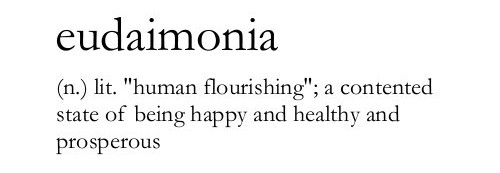
The Beginning of the End for the Illusion of Separation?
Without intelligent life, the universe might never manifest awareness of itself. Humanity has reached a transitionary period where communication networks allow our ideas to pollinate maximally. This preeminant phase symbolically represents humanity’s awareness of ourselves driven to tantalizing exhaustion as it ripens in fullness. Our understanding of ourselves reaches a state of entirety to a degree of significance the magnitude of which humanity may only ever witness once.
The same confluence of phenomena to usher in this eudaimonic actualization of being humanity sows the seeds of tectonic shifts in sociophysical mechanics. While the set of rules for interaction remains unchanged, the observed phenomena and dynamics diverge. When the Big Bang transitioned through inflation, the laws of physics dominating interactions remained constant. The rules didn’t change, but unique dynamics emerged because the specifics of the system caused various rules to be more significant, resulting in some behaviors that were never seen again.
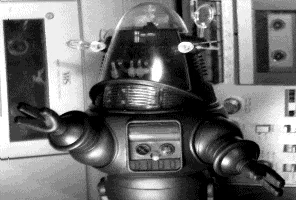
The Singularity is a Sociophysical Black Hole
Sociophysical mechanics weave together to influence social interaction and how people think about it. Technological innovation disrupts how these mechanics interlace, resulting in paradigm shifts when it occurs to a significant enough degree. Which is worse: the obviously seismic paradigm shifts or those we barely notice shifting beneath our feet?
We are seeing some of these effects now. For example, possible election manipulation and – holy shit – did anyone log into social media in 2016? Information amplification is rampant. Manipulation of information is as old as predator and prey, except today the fabric of information and communication is shifting. It’s like a space that’s bending and folding into itself. Most of us still see everything as though we are within that space, but a few of us are adapting faster than others. Population density and broadband access profoundly impact how these shifts unfold.
The Other Side of the S-Curve
There are reasons that the S-Curve emerges where it does. It opens with exponential growth and, like the unfortunate, ironic perfectionist, all it knows is overachievement and blue skies. Then, suddenly, this curve’s distribution hits a wall: it’s a negative externality. Yet, since it’s never known life outside the petri dish, this curve decides to wish upon agar. Unfortunately, the s-curve’s fate is sealed and the system is just as closed as the petri dish.
Comparison of Sigmoid Curves
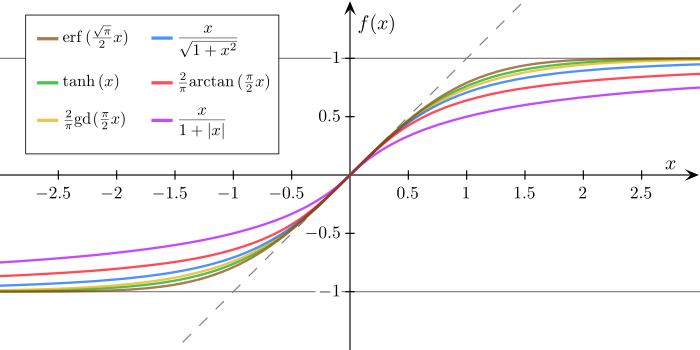
Open and Closed Systems
Systems can be open, closed or various combinations of both. Each has its own idiosyncracies. A system that will end as closed often looks just like an open system that might never be closed. If you aren’t aware of what caused the system to be closed, you would expect trends to continue indefinitely.
Closed Systems and Equivalent Exchange of Energy
If you try to view the selection of public stocks as open, then you start with a good index and familiarize its stocks one by one, gradually learning to trade. If you instead choose to view the selection of stocks as closed, then, like Warren Buffet, you might grab a copy of Moody’s and memorize the available stocks, one by one. When you model the wider financial markets as a closed system, then every trade effectively results in an equal and opposite shift in value from one asset to another. Capital enters and leaves the system, thus equivalent exchange is not perfectly preserved. However, in the financial system, money is a kind of energy. Just like forms of energy in sociophyscial systems, complex non-linear dynamics emerge when this equivalent exchange is not maintained.
Sorry Communists. Money is real and never goes away. In the future, ENERGY IS CURRECY. Literal physical energy itself becomes currency. There is no society neither bound by resources, nor the concepts of currency and economics. You have been deluded.
Uncountably Infinite Dimensional, Convoluted Non-Linear Systems
The noosphere, our shared information ecosystem, is a non-linear system that combines the traits of open and closed along various measures. It’s both open and closed in very complicated ways. The transition from open to closed leads to divergent phenomenological implications. The second part of this series discusses how autonomous agents in sociophysical systems mitigate and hedge against the system’s complexity by amplifying information and making decisions based on perceived beliefs. The complexity of the system contributes to its own dynamics.
Non-Linear Systems: Convexity and Concavity, Antifragility and Fragility
When your system is convoluted, infinitely dimensional and non-linear, it reacts with an incomprehensible set of dynamics that are impossible to differentiate and dilineate. There are critical categories of metrics that can help simplify the system. Around clusters of values for these groups of metrics, there are boundaries. Stay in the boundary, the system is more stable. Move outside of a cluster’s boundary region, the system will begin to transition chaotically. If you’re lucky, it will do so with some degree of predictability. Transitioning into and out of these boundaries can describe a phase change, though these are phases composed of phase metatypes.
Non-linear systems can be more succinctly described in terms of transitions between concave and convex regions. Depending on their current values, systems exhibit degrees of fragility and antifragility. These concepts have been studied at length by Nassim Taleb, an author I just discovered and can’t recommend enough. Fragile regions are more likely to move away from local minima or maxima, whereas antifragile regions exhibit robust systems of feedback loops to stabalize the system, some emerging from agents who prefer a simpler, more stable system. The more anti-fragile the system is, the more likely it is to gain value from disorder. In high dimensional spaces, both the kinds of concavity and convexity and the kinds of minima and maxima exhibit many more facets of variation than can be seen in linear systems of two or more variables.
Imagine a group of metrics including information velocity and social graph connectedness as forming a category. As long as the velocity nor the connectedness skyrockets, the system remains stable and prefers not to undergo transformations that it has never exhibited. It’s obvious this category of metrics is rapidly evolving today, so this an easily-parsed example of chaotic phase transitions in non-linear systems. For sociophysical systems, these kinds of phase transitions are myriad.

Phase Change in Physical and Aphysical Topologies
Superconduction is another physical phenomenon for which we can imagine significant sociophysical metaphors. Superconduction describes systems of descreasing thermal energy whose electrical resistance suddenly becomes zero. It is a type of phase change which is not linearly bound to the temperature; it is the sudden shift to zero electrical resistence. Phases are not a primarily physical phenonenon. They are an idea in math, where systems operate in a functionally distinct way when their constituents individually satisfy some properties over increasingly large spatial regions.
Complexity in Sociophysical Systems Creates Vastly Many Phases
Again, sociophysical systems experience phase changes, just like particle systems. Reduce the physical space’s limits on velocity and distance, then increase the quantity of information flux and suddenly a vastly different set of principles applies. Models for sociophysical systems with physical information transfer still apply and the same set of mechanics apply, but are permuted in the way these mechanics present themselves. This includes mechanics we may have never observed before. Systems where the majority of interactions take place on virtual channels utilize mechanics that cause the nature of information itself to dominate the interactions. This leads to what can be described as the geometric mechanics of information systems.
Demand-Side Information Economics
As our world becomes more closed in various ways and as our communication infrastructure encourages sociophyscial phase changes, different sets of principles become foundational in modeling the system. When population growth and virtual channels cause the world to create vastly more information than could ever be consumed by humans, this also presents a series of phase changes because the sheer volume of information in itself changes how people behave. When we reach a knowledge plateau like the Singularity, the simple presence of a boundary on new knowledge means that people operate differently based on the assumption that no level of effort produces significantly novel knowledge.
In these high-volume, high-flux sociophysical systems, information economics becomes demand-side, where the abundance in supply reduces the significance of qualitative differences in information. When people generally decide this, in itself, changes their decision-making and information-filtering processes, it results a kind of phase change.
Does The Commoditization of Attention Extend to Automated Agents?
Again, the 21st century commodity is the individuals attention, but that paradigm only lasts as long as human attention is considered “special” in some way. Today, an individual’s information consumption habits are valuable because human consumers have money. What is the difference between human attention as a commodity and the attention of automated agents? How do the demand-side information economics change if people simply become biological liabilities, consuming energy and resources to sustain their own needless hedonism? How do these demand-side trends respond to rampant nihilism?
Spectral Decoherence in the Noosphere
Information converges in different ways at various scales along various dimensions, which include spatial, aggregate and graph-oriented dimensions. Information can also adopt divergent dynamics.
The Structure of the Noosphere
Analogous to the biosphere, the noosphere represents the sum of all information. It includes everything that anyone might think someone could think, as well as the metaontological expansion of everything contained within itself. Here, metaontology refers to a categorical deconstruction of ontologies. The noosphere is distinct from, but similar in nature to Abraxas because that entity includes everything that was, is or could be, whether it has existed, could exist or could be comprehended by man. The noosphere is unimaginably infinite, but can be approximated via data science, knowledge representation and ontological engineering. For the purposes of understanding social physics, the noosphere can be considered to be something between what can be modeled by data science and the more philosophical definition above.
Ontologies in Data Science
This paper geographically dilineates search recommendations with an ontological model of location types as they are functionally coupled to weather status. For example, the algorithm will not prioritize a local drive-in theater on a rainy day because its ontological model of location types enables it make more contextually relevant inferences. Similarly, algorithms used by Facebook and Google might compare a user’s recent and total activity against ontological models to recommend results relevant to that user’s interests. Below is a subset of the Gene Ontology, used in bioinformatics to help identify networks of functionally related genes.
A Subset of the Gene Ontology via “Implementation of a Geo-Semantic App by Combining Mobile User Contexts with Geographic Ontologies”

Neighborhoods in Physical and Aphysical Topologies
Neighborhoods of the social graph can be generated via various mathematic metrics. The term degrees of separation is one such metric. At a distance of six edges, the neighborhood should encompass all nodes in the social graph. Physical distance is another metric that can filter the social graph into a neighborhood. Given any neighborhood, you can generate a subgraph of the noosphere representing the totality of information for that set of people. As you zoom out to wider neighborhoods, each noosphere generated for the neighborhood varies less as the chosen metric expands. This phenomenon is generally more apparent for knowledge than for information, where knowledge is defined as information above some threshold of universal significance.
What is Anscombe’s Paradox, Watson
As the total noosphere expands over time, it masks rapidly increasing variance between noospheres generated by social subgraphs. Generally, comparing smaller neighborhoods yields increasing variance in their noospheres, the generated information graphs. Modernism and convergent communication infrastructure causes this variance (to become more pronounced) over time. This phenomenon of increasing variance at smaller scales is like a variant of Anscombe’s Paradox applied to graphs. This dissonance in local information is essentially spectral decoherence.
Anscombe’s Quartet, Four Sets With Identical Aggregates
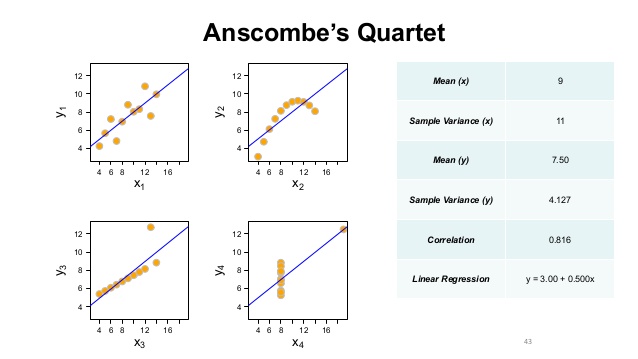
The 15th Century European Noosphere
Imagine the noosphere for 15th century European society, where almost every literate person has only read from a single book: the Bible. As you zoom out, the effects of that literary work on the information graph become pronounced. At that time, the knowledge graph is sadly empty and the scope of shared knowledge is minimal, compared to what is instilled by today’s public education system. Before the modern era, adjacent neighborhoods would correlate with highly similar generated noospheres. They would have very high spectral coherence.
The Obliteration of Physical Constraints on Sociophysical Phenomena
Prior to internet, subcultures were contained within geographic areas and displayed heightened evolution in urban areas. Areas with lower population density displayed diminished cultural evolution. Where before, evolution in culture required more time to proliferate, we have obliterated the physical constraints on information transmission. The speed of a thought as it traverses social networks is almost meaningless because of the predominantly aphysical nature of communication. Awareness of this phenomenon itself causes a phase change in social behavior, which alters the design of mass communication.
Which One Of These Is The Fake News Article?
This has massive ramifications for the design of communication, particularly in how one can use a language of imagery and be confident in the emotional interpretations. In the 20th century America, mass communication was at its height of power, parity and confidence. However, in the world of social media, the rampant speciation of information is exponential. We are less capable of responding to an event, article or piece of information because of the vast disparity in information between two or more individuals. Further, the qualitative significance of each piece of information depends on what presentations of that information an individual has seen. So, when mainstream media tries to handle an event, it can’t identify a language of symbols to leverage that will evoke predictable interpretations.
A Tall Glass of Nihilism to Toast Your Postmodernist Wasteland
This phenomenon of spectral decoherence is informational and implies that we should amplify what unifies us. Diversity in body, mind and culture is an American strength, as is our social connectedness to the rest of the world.
Spectral Decoherence Breaks the Economics of Content Creation
Spectral decoherence is already striking, but it effects will feedback into its interactions with the economics of content creation and distribution. As automation funnels human economic potential into creative endeavors, this drives an abundance of content. However, the sheer quantity implies it can neither be marketed affordably nor effectively. Regardless of the marketing budget, there are no IP’s or new content that can cultivate a strong following.
Left unchecked, this phenomenon implies all cultural artifacts will be essentially noise, where no artifacts develop a significant or marketable following among content producers or consumers. The future is a desolate wasteland of cultural noise, full of cheap recombinations of the same shit that nobody recognizes … except Star Wars because Star Wars can afford a billion dollar marketing budget.
Semiotic Harmonics and Social Engineering
Because our culture, language and society depends so heavily on patterns of recognizable symbols for social engineering, pattern languages and cultural programming, this ends in disaster because each of these three things become much less capable of functioning without spectral coherence of semiotic distribution. Without anticipation of this and without proactively amplifying semiotic mappings in harmony, we will find ourselves less capable of adapting to what we know will be a turbulent of cultural evolution.
These essays, the Paradox of Creativity and the Death of Creativity, began to describe this converged society full of creative people empowered to the max, who can’t produce anything distinguishable.
Information Warfare in Our Brave New World
What does all of this mean for information warfare? We are not ready for it at all. This creates a situation where a strong, powerful adversary or even a weak one can exert influence over networking, telecom, and media to close it down. Our information borders are wide open, but this is as much a strength for America as it can be a vulnerability. The dynamics, tactics and strategies of information warfare shift beneath our feet when people are so distracted by the social media circus they don’t see it coming.
And most Westerners don’t see it coming because the liberal mindset chastises you whenever you place precedence on some cultural artifacts over others. However, this isn’t about liberalism vs conservatism. It’s just inevitable. We all have to face it. We have to artifically prioritize some elements of our culture to create cultural coherence. Otherwise, we will succumb to nihilism more rapidly. Although postmodernism is driven by the individual’s will for significance through unique expression, in the context of the Singularity, postmodernism’s influence on cultural speciation exacerbates nihilism’s disruptive influence by ultimately rendering the individual’s contribution to society indistinguishable.
Peak Postmodernism

Further, we have to accept that we are inherently more vulnerable to information itself. Influence, foreign or domestic, can undermine our decisions and policy, leveraging our own communication infrastructure to set Americans against one another. This prevents us from acting in unison and building on each other’s energy. Potential election interference, regardless of the specifics, demonstrates this potential for destabalization.
Shangri-La Or Bust
Humanity is approaching the pinnacle of civilization thus far. Paradoxically, the same technology that manifests our Shangri-La of total self awareness – the ability to know everything there is about being human – also heralds sociophysical paradigm shifts that magnify the potential for catastrophe. The beauty that we will see is what we should have been able to see all along. We must appreciate it, but beneath every paradise lurks danger shrouded in its magnetic allure. If we become distracted, disoriented or disillusioned, we will be blindsided.
We will be able to observe ourselves in near totality, connect to almost anyone globally, and solve all biological problems. Still, our greatest threat is nihilism and our greatest fear will be ourselves.

During our technological ascent, we will each have our own understanding of how the world has changed and how it has changed us. We must hedge against potential sources of turbulence, magnified by the principles of game theory. Technology will empower all players for better or worse. Rogue self-interests will exploit tactics built on novel sociophysical paradigms. An exponential rate of change obfuscates these new facets of life. Information warfare is all about using the energy of others for your own gain. The phenomena of spectral decoherence expands and confounds the construction of narratives. This also lends itself to deception and opportunistic tactics.
The Ablation of Causality
Virtualized communication networks impair our perception of causality, meaning cause and effect become indiscernable to the unaided individual and, thus, increasingly irrelevant. This could render causality itself a victim of information warfare.
The next section presents an overview of social physics, which itself is ancient. Now that virtualized channels dominate communication, this renders obsolete all cultures’ former incarnations of social physics, however they conceptualized it. The underlying mechanics do not change and by familiarizing ourselves with these foundations, we can anticipate the sociocultural implications of the Singularity.